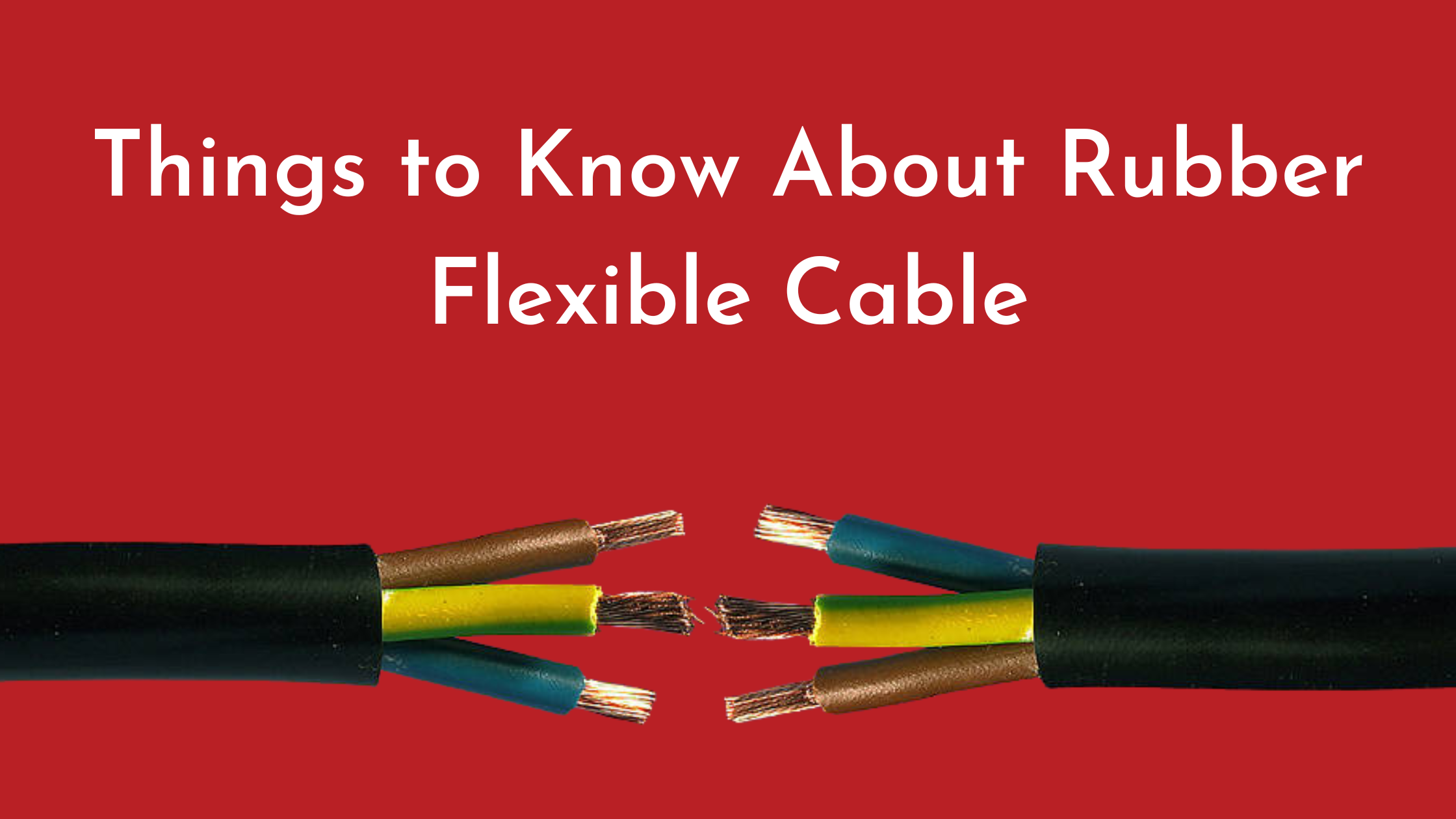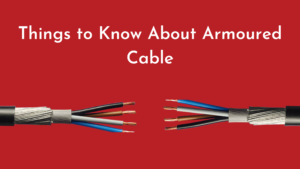An electrical cable is an electrical conductor that is used to transmit electrical power or signals from one point to another. Electrical cables are made up of a number of components, including one or more conductors, insulation to prevent electrical current from leaking or shorting, and a protective outer jacket to protect the cable from physical damage and environmental factors.
Table of Contents
ToggleVarious types of electrical cables are available worldwide, including power cables, armoured cables, rubber cables, fire resistant cables, aluminium cables, and more. Here we are talking about rubber cables, a very important type of electric wire.
What is Rubber Flexible Cable
Rubber flexible cable is a type of electrical cable that is made of rubber insulation and is designed to be flexible, allowing it to be easily installed in tight spaces or bent around corners.
Rubber flexible cables are often used in industrial settings, as they are resistant to oil, water, and other substances, making them suitable for use in harsh environments. They are also resistant to abrasion and can withstand mechanical stress, making them durable and long-lasting.
Rubber flexible cables are available in a range of sizes and ratings to meet the specific needs of different electrical systems. They are often used as trailing cables for portable electrical equipment, as well as for power distribution and control circuits.
Rubber flexible cables may be single-core or multi-core, depending on the number of conductors they contain. They may also be shielded to reduce electrical interference.
What is rubber cable used for?
Rubber flexible cable is primarily used in industrial settings for the transmission of electrical power or signals. It is often used as a trailing cable for portable electrical equipment, such as portable generators, welding machines, and other industrial tools. Rubber flexible cables are also used for power distribution and control circuits in factories, power plants, and other industrial environments.
Due to their flexibility and durability, rubber flexible cables are also commonly used in construction, mining, and other outdoor environments where they may be exposed to harsh weather conditions or mechanical stress.
They are also used in marine and offshore applications due to their resistance to saltwater and other corrosive substances.
In addition to their use in industrial and outdoor settings, rubber flexible cables may also be used in residential and commercial applications, such as for the wiring of appliances, lighting systems, and other electrical equipment. Overall, rubber flexible cables are a versatile and reliable choice for a variety of electrical applications.
What is rubber flexible cable made of?
Rubber flexible cable is typically made up of a number of components, including one or more conductors, insulation, and a protective outer jacket. The specific materials used in the construction of rubber flexible cables may vary depending on the specific requirements of the application.
- Conductors: Rubber flexible cables may be made of copper or aluminum conductors, depending on the specific requirements of the application. Copper is a good conductor of electricity and is generally more expensive than aluminum. Aluminum is also a good conductor, but it is less expensive than copper and is generally used in lower voltage applications.
- Insulation: Rubber flexible cables are typically made of rubber insulation, which is known for its flexibility, durability, and resistance to water, oil, and other substances. Rubber insulation is also resistant to abrasion and can withstand mechanical stress, making it a good choice for use in harsh environments.
- Outer jacket: Rubber flexible cables may also have a protective outer jacket, which is typically made of rubber or another durable material. The outer jacket serves to protect the cable from physical damage and environmental factors, such as water, oil, and UV radiation. It may also be color-coded to indicate the specific type of cable or its intended use.
Overall, the specific materials used in the construction of rubber flexible cables will depend on the specific requirements of the application and the environment in which the cables will be used.
What is the difference between flexible cable and cord?
Flexible cable and flexible cord are both types of electrical conductors that are designed to be flexible and able to bend easily. However, there are some key differences between the two:
- Cable vs. cord: Cable is a term that refers to an electrical conductor that is typically used for the transmission of electrical power. It is typically made up of one or more conductors, insulation, and a protective outer jacket. Cord, on the other hand, refers to an electrical conductor that is typically used for the transmission of electrical signals or to supply power to portable electrical equipment. It is usually smaller in size and less robust than cable, and may or may not have an outer jacket.
- Construction: Cable is typically made up of a larger number of conductors than cord, and is generally more robust and durable. Cable is also typically designed to withstand higher levels of electrical current and voltage than cord. Cord, on the other hand, is typically made up of fewer conductors and is more flexible and lightweight than cable.
- Applications: Cable is typically used for the transmission of electrical power over long distances, while cord is more commonly used for the transmission of electrical signals or for the connection of portable electrical equipment to a power source.
Overall, the main difference between flexible cable and flexible cord is in their intended use and construction. Flexible cable is typically used for the transmission of electrical power, while flexible cord is more commonly used for the transmission of electrical signals or for the connection of portable electrical equipment to a power source.
What is the difference between PVC and rubber cable?
PVC (polyvinyl chloride) and rubber are two common types of insulation materials used in electrical cables. There are a number of differences between PVC and rubber cables, including:
- Physical properties: Rubber is a natural material that is known for its flexibility, durability, and resistance to water, oil, and other substances. It is also resistant to abrasion and can withstand mechanical stress, making it a good choice for use in harsh environments. PVC is a synthetic plastic material that is known for its versatility and low cost. It is also resistant to water and oil, but it is not as flexible or durable as rubber.
- Electrical properties: Rubber cables generally have better electrical properties than PVC cables. Rubber has a higher dielectric strength and can withstand higher voltage levels, making it a good choice for use in high voltage systems. PVC cables are generally more suitable for low voltage applications.
- Temperature resistance: Rubber cables have a higher temperature rating than PVC cables and can be used in environments with higher temperatures. PVC cables are more sensitive to temperature changes and may become brittle or deform at high temperatures.
- Flame resistance: PVC cables are generally more flame resistant than rubber cables, which can melt or burn when exposed to high temperatures. This makes PVC a good choice for use in environments where fire safety is a concern.
- Cost: PVC cables are generally less expensive than rubber cables due to their lower cost of production.
Overall, the choice between PVC and rubber cables will depend on the specific requirements of the electrical system and the environment in which the cables will be used. Rubber cables are generally more suitable for use in harsh environments and high voltage systems, while PVC cables are a more cost-effective option for low voltage applications.
Are rubber cables waterproof?
Rubber cables are generally resistant to water and are often used in outdoor and marine applications where they may be exposed to moisture.
However, it is important to note that the term “waterproof” can be somewhat subjective and may depend on the specific properties of the rubber cable and the conditions in which it is used.
Most rubber cables are designed to be resistant to water, and they may be rated for use in wet or damp environments.
However, they may not be completely waterproof, and it is important to carefully consider the specific requirements of the application when selecting a rubber cable. For example, some rubber cables may be resistant to splashing water but may not be suitable for use in submerged or continuously wet environments.
Can you use rubber flex cable outside?
Yes, rubber flex cables can be used outside in certain applications. Rubber is a durable and flexible material that is resistant to water, oil, and other substances, making it a good choice for use in outdoor environments.
Rubber flex cables are often used in industrial settings, such as for the wiring of portable electrical equipment or for power distribution and control circuits in outdoor environments.
However, it is important to consider the specific requirements of the application when selecting a rubber flex cable for use outside. Rubber flex cables may be rated for use in different temperature ranges, and it is important to choose a cable that is suitable for the ambient temperature in the area where it will be used.
Rubber flex cables may also be rated for use in wet or damp environments, but it is important to ensure that they are properly protected from water and other substances to prevent damage to the insulation.
Where can I use rubber cable?
Rubber cable can be used in a variety of applications, both indoors and outdoors. Some common applications for rubber cable include:
- Industrial settings: Rubber cable is often used in industrial settings, such as factories, power plants, and other manufacturing environments, for the transmission of electrical power and signals. It is resistant to oil, water, and other substances, making it suitable for use in harsh environments. Rubber cable is also flexible and durable, making it a good choice for use as trailing cables for portable electrical equipment.
- Outdoor environments: Rubber cable is also commonly used in outdoor environments, such as in construction, mining, and other industrial applications. It is resistant to water and other substances, making it a good choice for use in wet or damp environments. Rubber cable is also resistant to abrasion and can withstand mechanical stress, making it a durable choice for use in outdoor environments.
- Marine and offshore applications: Rubber cable is often used in marine and offshore applications due to its resistance to saltwater and other corrosive substances. It is also flexible and durable, making it a good choice for use in these environments.
- Residential and commercial settings: Rubber cable may also be used in residential and commercial settings, such as for the wiring of appliances, lighting systems, and other electrical equipment. It is generally less expensive than other types of cable and is easy to install, making it a popular choice for these applications.
Overall, rubber cable is a versatile and reliable choice for a variety of electrical applications, both indoors and outdoors.
It is important to carefully consider the specific requirements of the application when selecting a rubber cable to ensure that it is suitable for the intended use.







